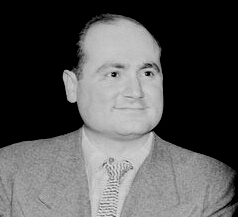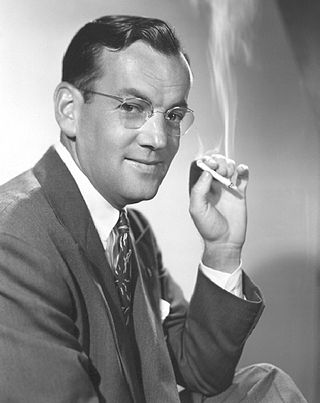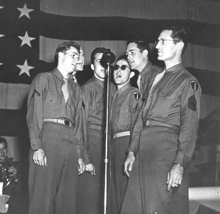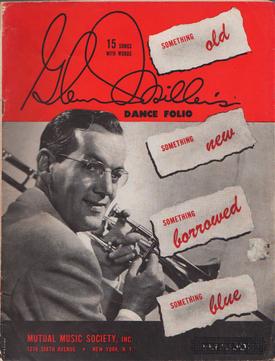Related Research Articles

Alton Glen "Glenn" Miller was an American big band conductor, arranger, composer, trombone player, and recording artist before and during World War II, when he was an officer in the US Army Air Forces. His civilian band, Glenn Miller and His Orchestra was one of the most popular and successful bands of the 20th century and the big band era. His military group, the Major Glenn Miller Army Air Forces Orchestra, was also popular and successful.

Glenn Miller and His Orchestra was an American swing dance band that was formed by Glenn Miller in 1938. Arranged around a clarinet and tenor saxophone playing melody, and three other saxophones playing harmony, the band became the most popular and commercially successful dance orchestra of the swing era and one of the greatest singles charting acts of the 20th century. As of 2024, Ray Anthony is the last surviving member of the orchestra.
The Glider Pilot, Liaison Pilot, and Service Pilot badges were qualification badges of the United States Army Air Forces issued during the years of World War II to identify a rating in one of three specialized, limited-duty pilot categories whose selection and training differed from that of the traditional military pilot.

A United States Aviator Badge refers to three types of aviation badges issued by the United States Armed Forces, those being for Air Force, Army, and Naval aviation.

Johnny Desmond was an American singer who was popular in the 1940s, 1950s and 1960s.

John Chalmers MacGregor, better known as Chummy MacGregor, a musician and composer, was the pianist in The Glenn Miller Orchestra from 1936 to 1942. He composed the songs "Moon Dreams", "It Must Be Jelly ", "I Sustain the Wings", "Doin' the Jive", "Sold American", "Cutesie Pie" in 1932 with Bing Crosby and Red Standex, and "Slumber Song".

The Air Training Command (ATC) is a former United States Air Force (USAF) Major Command designation. It was headquartered at Randolph Air Force Base, Texas, but was initially formed at Barksdale Air Force Base, Louisiana. It was re-designated as Air Education and Training Command (AETC) following a merger with Air University (AU) on 1 July 1993.

Jerry Gray was an American violinist, arranger, composer, and leader of swing dance orchestras bearing his name. He is widely known for his work with popular music during the Swing era. He worked with the bandleaders Artie Shaw and Glenn Miller.

Norman Fowler Leyden was an American conductor, composer, arranger, and clarinetist. He worked in film and television and is perhaps best known as the conductor of the Oregon Symphony Pops orchestra. He co-wrote with Glenn Miller the theme "I Sustain the Wings" in 1943, which was used to introduce the World War II radio series.

Wings Up is a short propaganda film produced during World War II, highlighting the role of the United States Army Air Forces Officer Candidate School. The film emphasized that while usually these courses would take up to a year in college, the country was at war now and needed all the qualified officers it could get and fast. The curriculum is briefly outlined in Wings Up as well as the kind of life a student would lead at this training center.
During World War II, the United States Army Air Forces (USAAF) established numerous airfields in Florida for antisubmarine defense in the western Atlantic and Gulf of Mexico and for training pilots and aircrews of USAAF fighters, attack planes, and light and medium bombers. After early 1944, heavy bomber crews also trained in the State. However two major operations in Florida were the School of Applied Tactics and the air Proving Grounds which tested and developed new capabilities.
In Wisconsin multiple airfields were constructed and used by the United States Army Air Forces during World War II. The main purpose of these installations was for training pilots and aircrews of USAAF fighters and bombers.

Between 1938 and 1944, Glenn Miller and His Orchestra released 266 singles on the monaural ten-inch shellac 78 rpm format. Their studio output comprised a variety of musical styles inside of the Swing genre, including ballads, band chants, dance instrumentals, novelty tracks, songs adapted from motion pictures, and, as the Second World War approached, patriotic music.

The United States Army Air Forces was the major land-based aerial warfare service component of the United States Army and de facto aerial warfare service branch of the United States during and immediately after World War II (1941–1947). It was created on 20 June 1941 as successor to the previous United States Army Air Corps and is the direct predecessor of the United States Air Force, today one of the six armed forces of the United States. The AAF was a component of the United States Army, which on 2 March 1942 was divided functionally by executive order into three autonomous forces: the Army Ground Forces, the United States Army Services of Supply, and the Army Air Forces. Each of these forces had a commanding general who reported directly to the Army Chief of Staff.
Murray Kane was an American Corporal, composer and band manager. As a performer, he was a member of the Crew Chiefs vocal group and the Glenn Miller Orchestra.

The Crew Chiefs were a vocal group popular in the 1940s, known for accompanying Tex Beneke, Glenn Miller, and Ray McKinley. Member Artie Malvin co-wrote the song "I'm Headin' For California" with Glenn Miller in 1944.

"7-0-5" or "Seven-O-Five" or "705" is an instrumental composed by Glenn Miller in 1943. The instrumental was performed by the Army Air Force Orchestra under the leadership of Capt. Glenn Miller in 1943-1944 and in 1945 under Sgt. Jerry Gray.

"I Sustain the Wings" is a 1943 big band and jazz instrumental co-written by Glenn Miller. The instrumental was the theme for the eponymous radio program broadcast on CBS and NBC from 1943 to 1945.

"It Must Be Jelly ('Cause Jam Don't Shake Like That)" is a 1942 jazz and pop song recorded by Glenn Miller and His Orchestra. The song was released as an RCA 78 single by Glenn Miller in 1944. Woody Herman also released the song as a single and as a V-Disc.
References
Sources
- Simon, George Thomas. Glenn Miller and His Orchestra. NY: Crowell, 1974.
- Simon, George Thomas (1971). Simon Says. New York: Galahad. ISBN 0-88365-001-0.
- Flower, John. Moonlight Serenade: A Bio-discography of the Glenn Miller Civilian Band. New Rochelle, NY: Arlington House, 1972.